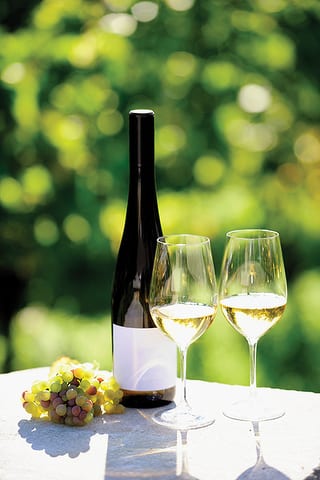What do you know about Riesling? If someone asked you, ‘What is Riesling?’ how many of you would say, ‘It’s a sweet white wine from Germany’?
While it’s true that Germany produces 60 percent of the world’s Riesling, the grape also is grown all over the world — Canada, Alsace (France), upstate New York, Washington State, Austria, and Australia have all had success with Riesling. One of the oldest known wine grapes in the world, Riesling is a hardy grape that needs cool to cold climates to really express its trademark acidity, which then translates into a unique, delicate lightness. Its structure is complemented by the mouth-wateringly delicate flavors of fresh ripe peaches, apricots, and melons, sometimes with a vibrant mineral quality.
In terms of bouquet, Riesling aromas can be very complex and layered with notes of apple, lime blossom, lemon zest, lychee, peach, and commonly petrol/diesel. It is said that the scent of burnt rubber/petrol/diesel is a result of Riesling being grown under the right conditions — very ripe grapes, lots of sunshine, warm soils, and cool to cold climate — and that the fuel-like smell is often considered to be an indication of a higher quality wine.
So don’t ever be put off by a Riesling that reminds you of your car in a not-so-good way — it’s generally considered a good sign and typical of the grape.
But let’s get back to the “it’s a sweet white wine” part of our discussion. It is true, Riesling can indeed be quite sweet. But it can just as easily be bone-dry and often beautifully elegant. And this is probably the biggest conflict facing Riesling producers in this day and age — people have one experience with Riesling and categorize it based on that one experience, falsely assuming all Rieslings are the same, which couldn’t be further from the truth! While some of the same flavor profiles will likely always be present in most Rieslings — green apple and some citrus, with varying degrees of peach, nectarine, lychee — the way those flavors present themselves can be vastly different.
In Alsace, France, the Rieslings produced are quite dry, perhaps not as delicate as the dry Rieslings from Germany. They are fuller-bodied with flavors of gunflint, mineral, and even steel — beautifully mingled with peaches, plums, and limey citrus. In Germany, dry Rieslings are finely carved, elegantly nuanced, relatively low in alcohol, with bracing acidity that is balanced by just the right touch of sweetness.
In the Finger Lakes region of upstate New York, Rieslings are light in body and flavor and often quite crisp. (For an excellent example of a dry Finger Lakes Riesling, try Hermann J. Wiemer 2014 Riesling Reserve Dry — the nose was full of canned peaches/fruit cocktail and papaya; on the palate, it was medium-bodied with flavors of honeydew, quince, but the finish was clean and lovely due to its perfectly balanced acidity.)
But knowing Riesling can be both sweet and dry is where the real confusion begins. How does one know whether the wine inside the bottle labeled “Riesling” is very dry or very sweet, or somewhere in between? Well, back in the day, if you picked up a German Riesling, you had to know that wine labeled “trocken” was dry, “spatlese” was sweeter than trocken but not necessarily sweet, per se; “Auslese” is typically semisweet or sweet, made from very ripe, hand-selected bunches of grapes; and “beerenauslese” signified a rich, sweet dessert wine. As for Rieslings from other countries, you might find the words “off-dry” or “semisweet” to help you out, but to what degree these wines are sweet or dry remained somewhat subjective.
In 2008, Riesling producers from around the world gathered to form the International Riesling Foundation (IRF) to combat this very confusion in the wine market. Their solution was to come up with the IRF sweetness scale. The scale appears on the back label of more than 30 million bottles of Riesling in the US market, so that consumers can see the level of sweetness of the wine inside the bottle simply by looking at the back of the bottle. The scale ranges from “dry” to “sweet,” with “medium dry” and “medium sweet” markers in between. The level of sweetness of such wines is indicated somewhere on the scale, and, as a consumer, all you have to do is look at the back label to see where on the scale the wine falls. The value of such a scale is obvious — consumers can more confidently purchase the wine they want because they are better informed. But it’s important to know the level of sweetness of a Riesling because there’s more to it than whether you just like dry or sweet wines. That is, Riesling is arguably the best varietal wine to pair with food, whether the wine is dry or sweet, but depending on the cuisine, one would want to know the level of sweetness in the wine and purchase accordingly
Dry Rieslings can pair with seafood and poultry, pastas with light sauces, but you’d want a sweeter Riesling to pair with spicier foods. Heavily seasoned or spiced cuisines such as Cajun, Thai, and Mexican are well-served by being paired with a medium-sweet Riesling — the spice really makes the wine’s flavors explode in the best possible way. Very sweet Rieslings can be served as dessert by themselves or are good to pair with less sweet desserts, such as angel food cake and cheesecake, or paired with flavorful soft cheeses.
With warm weather finally here, and as you prepare deck parties and picnic fare, do yourself a favor and pick up a bottle of Riesling. Serve it with food — and if you’ve given some thought to the pairing, I guarantee you will not be disappointed. In fact, I think there’s a good chance you’ll be quite impressed, and maybe Riesling won’t be such a stranger to you anymore.



